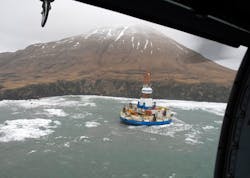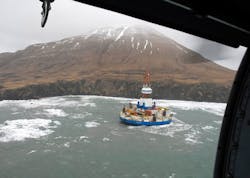The Kulluk, a conical drilling unit, was safely towed to a harbor on Kodiak Island in the Gulf of Alaska where it will undergo a thorough safety assessment before resuming its journey to its winter harbor in Seattle for repairs and maintenance, said Royal Dutch Shell PLC.
Kulluk was driven aground by violent weather on the southeast shore of the uninhabited Sitkalidak Island on Dec. 31, 2012, while under tow in high seas to Seattle. The incident resulted in no significant injuries and no environmental impact.
None of the 139,000 gal of diesel on the Kulluk, which remained upright throughout the incident, appears to have spilled, USCG reported after repeatedly flying over the Kulluk while it was grounded. Crews also reported no indication of leaking fuel while the Kulluk was being moved to Kodiak Island.
Shell owns the unit, which was built in 1982 as a purpose-built vessel for Gulf Canada Resources Inc. to extend the drilling season in the Beaufort Sea. Noble Corp. manages the Kulluk for Shell, which bought it in 2005 (OGJ Online, Jan. 2, 2012).
After initial delays caused by weather and high seas, Shell and USCG refloated the Kulluk and attached a towing line to it on Jan. 6. The drilling unit was towed Jan. 7 to a safe harbor about 40 miles from where it ran aground. (OGJ Online, Jan. 7, 2013).
Shell said preliminary reports indicated some damage resulted above the deck, and seawater entered through open hatches, knocking out the Kulluk—s regular and emergency generators. Salvage crews put portable generators onboard.
Shell Oil Co. Pres. Marvin Odum said, "We undertake significant planning and preparation in an effort to ensure these types of incidents do not occur. We—re very sorry it did…. At this stage, it—s too early to gauge any impact on our ongoing exploration plans."
He said Shell will participate in USCG—s "investigation into the causes of this incident and will implement lessons learned."
Last year, Shell used the drilling unit for Arctic drilling off Alaska. The floating drilling unit is shaped like a large, conical donut (see drawing, OGJ, Oct. 1, 2007, p. 40).
On Jan. 2, a team of salvage experts boarded the grounded Kulluk to assess its structural integrity and to finalize salvage plans developed by the Kulluk Tow Incident Unified Command.
A USCG helicopter lowered the team to the Kulluk for a 3-hr assessment before hoisting the team off the drilling unit.
USCG also delivered a state-owned emergency towing system that was used during recovery operations, which were directed by Smit Salvage.
US Rep. Ed Markey (D-Mass.), wrote to Shell and USGC requesting more information on the incident. Markey, who is on the House Natural Resources Committee, also requested more details on Shell—s ongoing plans to drill safely offshore in the Arctic—s severe weather.
Shell called the grounding a maritime transit incident and not a drilling incident. More than 600 people were involved in response efforts managed by USCG.


